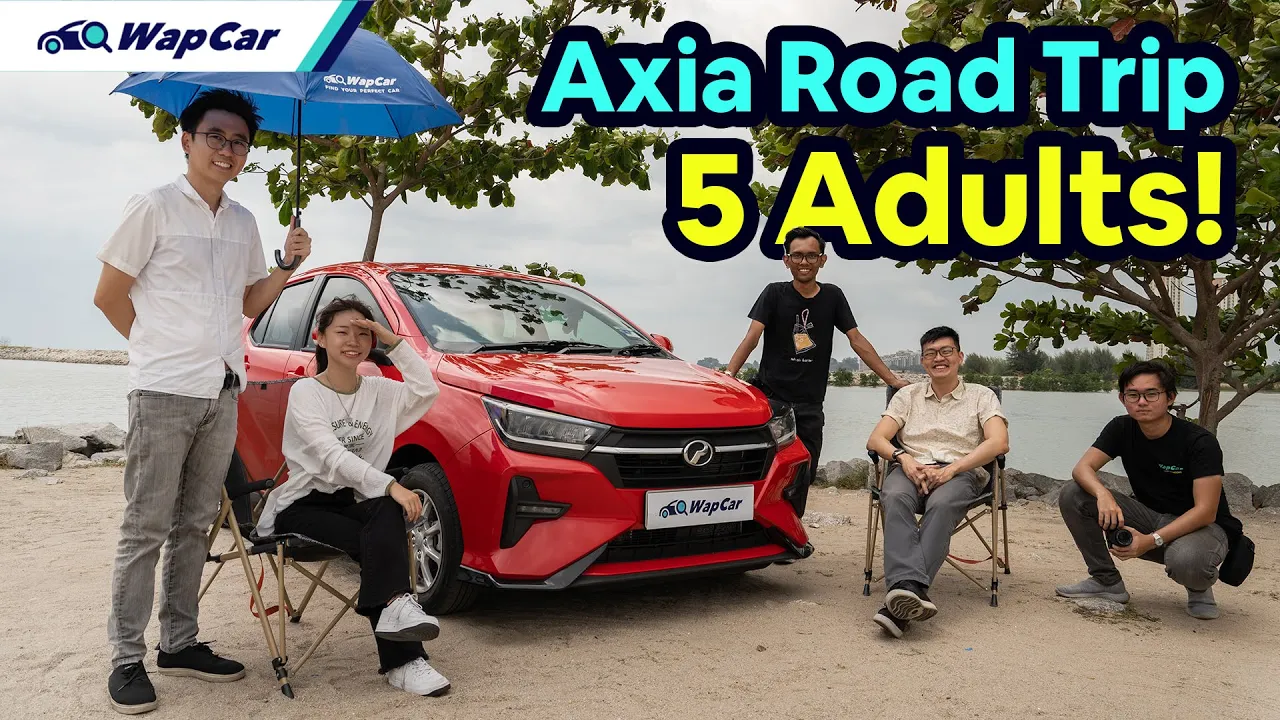
When I first saw pictures of the Kia Stinger online after it was unveiled in 2017, I was very impressed with how Kia designs have evolved all these years. Unknowingly, I developed a liking of the car although I have doubts if it will ever reach our shores. I had a bad perception of Kia those days due to their bad reputation in design and reliability, although I must say their design improved significantly when they brought in Peter Schreyer. What I like about the Stinger is the amount of effort and seriousness Kia put on the model which is out of their normal playing field. Development took more than 6 years, and they even brought in former BMW M vice president, Mr. Albert Biermann to help tune the handling. I love the fact that the Stinger conceptually is a grand turismo, not a full hard-edged sports car that may be less bearable to live with as a daily commuter for a family with kids. As their Chief Designer, Gregory Guillaume, put it in his words, “The new Kia Stinger is a true gran turismo, a car for spirited long-distance. It's not about outright power, hard-edged dynamics and brutal styling all at the expense of luxury, comfort and grace. The Stinger has nothing to do with being the first to arrive at the destination—this car is all about the journey”. When Naza Kia Malaysia (NKM) teases the arrival of the Stinger in Malaysia, I was very intrigued. I watched countless videos and read online reviews which mostly are very positive. When it was eventually introduced in Malaysia in July 2018, I know I must have one.
Choosing the Kia Stinger
I wasn’t really in the market for a new ride as I am happy with my issue-free 2016 Honda Civic 1.5 TC but somehow I was very keen on the Stinger. I don’t know what witchcraft Kia put on me. I even flew to NKM PJ Red Cube to see the car in person before firmly deciding. After letting go of my Civic to a businessman, I finally managed to get my hands on an “aurora black” Kia Stinger GT-Line 2.0 in 2018 for GST-free price of RM 241k. Had to drive 200 km to the nearest NKM branch in Miri to pick it up. I choose the 2.0 GT-Line variant instead of the top trim 3.3 V6 GT variant mostly due to cost of ownership and the value it already brings. The GT-Line was already spec’ed to the brim by NKM, which includes sunroof, ventilated front seats, heads-up display, 15-speaker 720W Harman/Kardon audio setup, electric seats & steering adjustment with memory function, 360-degree camera, wireless charger, Android-auto, Apple CarPlay, dynamic bending light, auto-dimming side and rearview mirrors, 7-airbags, acoustic laminated windshield, smart motorized bootlid, blind-spot assist, rear-cross traffic alert, tyre-pressure monitoring system (TPMS), launch control, limited-slip differential, electronically adjusted suspension, traction control, hill start assist, anti-lock braking system (ABS), torque vectoring control, vehicle stability management and many more. The 3.3 V6 GT variant adds on the bigger engine, red Nappa leather seats, additional digital gauges (G-force, torque, turbo boost, etc.), Brembo brakes and larger 19-inch wheels. Other-wise, from interior appointments, both are almost identical. The 3.3 GT will definitely have much higher roadtax, insurance and maintenance cost due to its larger powerplant and price. The 2.0 turbocharged direct-injection (TGDI) version is not a slouch either, churning out 252hp, 353 Nm through an 8-speed automatic gearbox. More than enough for daily needs and occasional spirited driving.
Design
The car’s design is just beautiful. Smooth sumptuous curves with minimal line creases, and a nice muscular rear haunch, accentuating the “coke bottle” inspiration it took. In the flesh, it definitely gets attention. Some may mistake it for a Maserati (well, it maybe is a Maserati from the east!). From the rear, it’s pretty muscular with functional quad-tip exhaust. The red light/reflector strip on the sides is a polarizing design feature, which some likes it and some doesn’t. I personally don’t love it, but it does add a quirky character to the design. There are functional air vents on the car, two frontal vents channelling air to create smooth air “curtain” around the front wheels for aerodynamics and two side vents venting hot air from the front brakes to cool them. Sadly, there are also fake vents particularly on the bonnet and rear bumpers, which are just for show. I choose the black colour to disguise those fake vents and it certainly helps.


Interior

When I sat in the car and closes the door (with a nice weighted “thud”), the seat and steering electrically adjust to the last settings, which makes it feel upmarket. The seating position is low with your legs stretching forward. Cosy and cocooned but not claustrophobic. This low seating position makes you feel “special”, unlike other normal sport sedans. If the day is hot, or if you are sweating, just turn on the ventilated seats and you are in good hands. Rear passengers enjoy proper thigh support from the bench, comfortably reclined backrest and ample knee room. You can’t slip your feet under the front seats as they are mounted pretty low, but it wouldn’t be an issue for us Asians. Headroom is enough but maybe a bit tight for tall people. The materials felt premium but not too luxurious. It’s a step up from normal cars (even better than some rival German sedans), but not to the level of higher-end luxury cars. There are a fair amount of leather, soft-touch plastics, hard plastics, aluminium trims and piano black trims all around, but put together nicely and tastefully. The suede headliner especially feels nice to the touch. The layout is ergonomic and familiar like most Korean/Japanese cars. I especially like the balanced use of analogue and digital appointments. The instrument cluster, for example, has analogue gauges for speedo, tacho, fuel and coolant temperature but with a digital central screen showing other important details. To me, cars nowadays try to feel high-tech by showing too much information in the central display and this makes the display looks cluttered, but this is not the case with the Stinger. The physical buttons and knobs are quite tactile, but not to the level of Audi’s. Audio system is superb! Crisp and punchy. The steering has a good girth that fits my hands perfectly (not as thick as newer BMWs) and has nicely tactile switches. The fitment feels solid, although I have a slight gripe with occasional creaks in the door panels which occurs when I start driving from cold to hot weather (e.g. getting out from a shaded garage to a hot sunny day). This disappears after a few minutes, and will not be heard if you switch on the audio system, but for a car costing this much, it should not be there in the first place.



The Drive
This car is fun to drive! Its rear wheel driven with approximately 52:48 weight distribution as the engine is mounted just behind the front axle, and the battery placed under the boot at the rear end. Feels a lot like continental European cars. You will feel isolated from the outside once you are in and closed the door. I’m normally annoyed by the auto-start stop as it is not really smooth when the car restarts, so I normally switch this off. There are 5-drive modes, Smart, Eco, Comfort, Sport, and Sport+. I usually leave it in Eco for normal city drives, and put on Smart for long-distance, which adjusts the mode automatically according on how aggressive we are on the pedal. Occasionally on Sport mode when I’m carving nice corners. You do feel the difference in the throttle response and gear change mapping between these modes. If you floor the pedal, there’s a very slight turbo lag, but when the boost comes in, the car really pulls! Feels like all the 353 Nm torque on tap! The 8-speed transmission shifts pretty good too. It may be not as fast as a DSG/DCT but who cares as it gets the job done well. The steering is nicely weighted and not overly assisted. The Stinger really is a true grand turismo. Long distance journeys are very pleasant and comfortable, and there’s power when you need it. It’s quite a heavy car at 1.6 tones, and although it’s very stable at high speeds and sweeping long corners, it is not as nimble as the BMW G20 330i. I took road trips from Bintulu to Sabah through Brunei and it performed superbly going uphill in Keningau/Kimanis road at the Crocker Range. Occasionally had a go >200km/h when road is straight and clear. Solid and stable. Puts a smile on my face everytime. There is room for improvements to better cushion the ride when going over sharp bumps, which can feel a bit jarring at times. The car rear end also unsettles a bit if you hit sharp undulations in mid-corner, but then this may mean its drift-happy (although I will not try that!). All in all, the car is tuned on the “sportier” side, but still has pleasant ride for daily commutes.

Performance [4/5]: Drive train was good. Fuel consumption is decent but a bit higher compared to rivals
Ride & Handling [4/5]: Superb despite minor glitches explained above
Quality [4/5]: Material choices are great. Would score higher if it wasn’t for the occasional creaks.
Features [4.5/5]: Packed to the brim even without advance driver assists (which I didn’t mind)
Practicality [4/5]: Easy to load boot, enough space for passengers, foldable rear seats
Value [4/5]: At the price when I bought it, it was spec’ed pretty well against rivals
Owner’s Verdict [Final score: 4/5]
I did have a go in the new BMW G20 330i and it outperforms the Kia Stinger in terms of engine performance and nimbleness. But the BMW does have a harsher ride, a lower perceived interior quality and features that I am personally not fond of (steering wheel too thick for my liking, a tachometer running counter-clockwise among others). The BMW G20 320i is a more balanced but tamer version of the 330i, and personally I find it’s less engaging than the Stinger. The Volvo S60 T8 was pretty powerful and packed with latest driver assistance, but to me the car felt too heavy in sharp turns, has not so great digital instrument cluster screen resolution and I’m a bit sceptical on the long-term ownership of hybrid cars in Malaysia. The Stinger is a solid car in its own right. I choose the car for its engineering and features which fits what I wanted. It does all this in spades. Kia’s current reliability reputation is now recognized internationally, and this being a CBU unit makes it a relief. So far no warranty parts were broken in my 1.5-year ownership. Maintenance-wise, parts are still affordable (oil filter costs RM 27), but you need to pay more for the 4L + 1L + 1L bottle of fully synthetic engine oil (capacity 5.7l). I also applaud the service provided by NKM Miri. Overall, I am a very satisfied owner. The car drives nicely, packaged well and makes you feel special. It’s the underdog that surprises even the top dogs. I always look back at the car and smiles when I walk away after parking. This Kia Stinger is a keeper.















